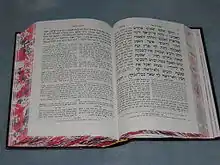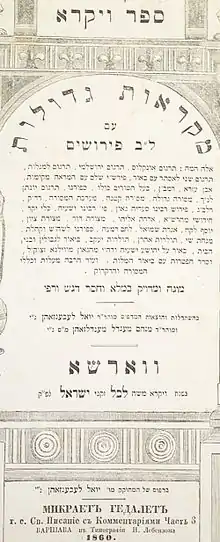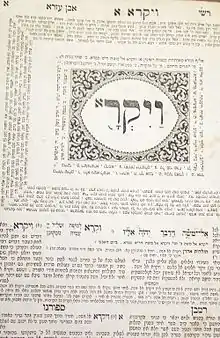Mikraot Gedolot
The Mikraot Gedolot (מקראות גדולות) "Great Scriptures," often called the "Rabbinic Bible" in English,[1] is an edition of the Tanakh (in Hebrew) that generally includes four distinct elements:
- The Biblical text according to the masorah in its letters, vocalization, and cantillation marks
- Masoretic notes on the Biblical text
- Aramaic Targum
- Biblical commentaries (most common and prominent are medieval commentaries in the peshat tradition)
Numerous editions of the Mikraot Gedolot have been and continue to be published.



Commentaries
In addition to Targum Onkelos and Rashi's commentary – the standard Jewish commentaries on the Hebrew Bible – the Mikraot Gedolot will include numerous other commentaries. For instance, the Romm publishing house edition of the Mikraot Gedolot contains the following additional commentaries:[2]
- Targum Jonathan (For the Torah, Pseudo-Jonathan)
- Targum Yerushalmi on the Torah
- Rashbam
- Tosafot on the Torah (Daat Zekenim)
- Chaim ibn Attar (Or Hachaim)
- Abraham ibn Ezra
- David Kimhi (Rada"k)
- Nahmanides
- Gersonides
- Jacob ben Asher (Ba'al Haturim)
- Obadiah ben Jacob Sforno
- Shabbethai Bass (Siftei Chakhamim)
- Obadiah of Bertinoro (Emer Neka)
- Shlomo Ephraim Luntschitz (Kli Yakar)
- Don Isaac Abrabanel
- Joseph Kara
Newer editions often include Baruch Halevi Epstein's Torah Temimah.
Editions of the Bomberg Mikraot Gedolot
First published in 1516–17 by Daniel Bomberg in Venice, the Mikraot Gedolot was edited by Felix Pratensis. The second edition was edited by the masoretic scholar Yaakov ben Hayyim in 1525. [3]
All of its elements - text, masorah, Targum, and commentaries were based upon the manuscripts that Ben Hayyim had at hand (although he did not always have access to the best ones according to some, Ginsburg and some others argued that it was a good representation of the Ben Asher text).
The Mikraot Gedolot of Ben Hayyim, though hailed as an extraordinary achievement, was riddled with thousands of technical errors. Objections were also raised by the Jewish readership, based on the fact that the very first printing of the Mikra'ot Gedolot was edited by Felix Pratensis, a Jew converted to Christianity. Furthermore, Bomberg, a Christian, had requested an imprimatur from the Pope. Such facts were not compatible with the supposed Jewish nature of the work; Bomberg had to produce a fresh edition under the direction of acceptable Jewish editors. Nevertheless, this first edition served as the textual model for nearly all later editions until modern times. With regard to the Biblical text, many of Ben Hayyim's errors were later corrected by Menahem Lonzano and Shlomo Yedidiah Norzi.
The Mikraot Gedolot of Ben Hayyim served as the source for the Hebrew Bible translation in the King James Version of the Bible in 1611 and the Spanish Reina-Valera translation.
A scholarly reprint of the 1525 Ben-Hayyim Venice edition was published in 1972 by Moshe Goshen-Gottstein.[4]
Recent printed editions
Most editions until the last few decades, and many editions even today, are reprints of or based on late nineteenth century Eastern European editions, which are in turn based more or less on the Ben Hayyim edition described above.
In the last generation fresh editions of the Mikraot Gedolot have been published, based directly on manuscript evidence, principally the Keter Aram Tzova, the manuscript of the Tanakh kept by the Jews of Aleppo. These also have improved texts of the commentaries based on ancient manuscripts. Three of these editions are:
- the Bar Ilan Mikraot Gedolot ha-Keter, ed. Menaḥem Cohen (21 volumes: Genesis (2 vols.), Exodus (2 vols.), Leviticus, Numbers, Deuteronomy, Joshua & Judges (1 vol.), Samuel, Kings, Isaiah, Jeremiah, Ezekiel, Minor Prophets, Psalms (2 vols.), Proverbs, Job, Five Megillot (1 vol.)), Daniel-Ezra-Nehemiah, Chronicles.
- Torat Hayim, published by Mosad ha-Rav Kook (15 vols: Torah, Psalms, Proverbs, and five Megillot).
- Chorev Mikraot Gedolot, published by Hotzaat Chorev (Torah only).
References
- Martin Sicker An introduction to Judaic thought and rabbinic literature 2007 Page 158 "Moreover, the so-called Rabbinic Bible, the Mikraot Gedolot (“Great Scriptures”), may have as many as ten different commentaries, and notes on the commentaries accompany the text, thus providing a range of possible interpretations of ..."
- Mikraot Gedolot: Vayikra (in Hebrew and Aramaic). Vilna: Romm Publishing House. 1899. Retrieved 23 July 2013.
- https://seforimblog.com/2008/03/some-notes-regarding-first-second/
- M. H. Goshen-Gottstein (ed.), Mikraot Gedolot, Biblia Rabbinica, A Reprint of the 1525 Venice Edition (Makor, Jerusalem, 1972)
Sources
- Menaḥem Cohen, "Introduction to the Haketer edition," in Mikra'ot Gedolot Haketer: A revised and augmented scientific edition of "Mikra'ot Gedolot" based on the Aleppo Codex and Early Medieval MSS (Bar-Ilan University Press, 1992).
External links
- Mikraot Gedolot - Haketer (Bar Ilan University website)
- Reconstructing the Bible (haaretz.com website)
Wikimedia projects
Wikisource's Mikraot Gedolot is available in Hebrew (has the most content) and English.
Editions available online
- The Second Rabbinic Bible (Mikra'ot Gdolot)
- Mikraot Gedolot AlHaTorah - free customizable online edition, including up to 26 different commentators, some newly published or in critical editions
- The Second Rabbinic Bible (Mikraot Gedolot) (מקראות גדולות) Volume I, Yaakov ben Hayyim, 1524;
digital copy: Yaakov ben Hayyim, 1524: The Second Rabbinic Bible (Genesis through Deuteronomy only) - 1912 Vilna Edition